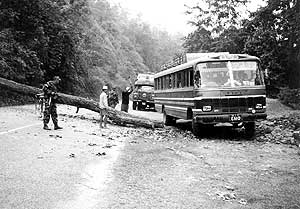 BOTULPUR, DANG - Fear lives here, as real as an explosion in the dead of night, as intangible as a mythical demon from the dark tales of centuries past. We came here to find out what everyone in the capital, Singha Darbar and the newsrooms of the nation, was afraid of. We also wanted to shed some light on this murky war of press releases couched in patriotic piety and the growing paternalism of authority.
BOTULPUR, DANG - Fear lives here, as real as an explosion in the dead of night, as intangible as a mythical demon from the dark tales of centuries past. We came here to find out what everyone in the capital, Singha Darbar and the newsrooms of the nation, was afraid of. We also wanted to shed some light on this murky war of press releases couched in patriotic piety and the growing paternalism of authority. The remote battlefields of the middle-hills lie concealed behind the mists of early winter, and the uncertainties of a self-censoring press treading new territory. I hoped to hear the real story from intrepid local journalists, campaigning NGOs or ordinary people caught in a war zone. The latter, at least, did not disappoint.
From the beginning, our trip was fraught with risk, real and imagined. The drive from Nepalganj to Tulsipur took us along a deserted Mahendra Highway. Armed police at the lone checkpost looked us over sceptically, but it was too cold for more than a perfunctory search. Up we drove into hills wreathed in low cloud, along a narrow bumpy road little better than a path.
Halfway along, I realised this hadn't been a wise choice of route, from the point of view of safety. You couldn't see more than a hundred metres, and thick jungle grew right up to the roadside. We stopped an outbound bus and he told us the 12 remaining kilometres to the Dang valley were clear, no fallen tree check points, no land mines that he was aware of. I thought of my first aid kit, sitting at home in Kathmandu, forgotten by the door in the rush to get going.
Emerging at the top of the outer Mahabharat hills, we were above the clouds, awash in sunlight. A sense of security flooded over us with the warmth, but the descent into cloudy dankness restored the fear of the unknown. A forest admired from above for its lushness became a haven for beasts, an ambuscade concealing guerrillas in the mist. Later, safely in Tulsipur and feeling slightly foolish, we laughed about our concerns.
But then a local human rights activist told us we'd driven through two "Maoist villages" on our way down the hills. All we saw were people going to offer puja, or beginning the day's labour. No camouflage or side arms in sight.
We heard about the explosion in nearby Botulpur, seven, possibly eight, dead after what seemed to be a ghastly accident. "Don't go there," advised our activist friend. The army may stop you and there could be Maoists along the way. By now, we were getting tired of bogie men lurking in the bushes so we took a local guide and set off. The road lead across a dry river-bed, empty of both water and rebel fighters. Another safe passage despite local advice, but we're not feeling cocky or proud of ourselves.
In the village a grim, yet somehow encouraging drama awaited us. Up on the river bank, behind a screen of trees, a wrecked house was the centre of village attention. Several dozen people were bent over shovels and baskets, clearing rubble and poking gingerly through piles of broken mud bricks and scraps of paper. It was the detritus of a family's life wrecked by violence, by ideology, by a dreadful mishap involving Maoist bomb makers and at least six innocents. I averted my gaze as I walked over a heap of earthen shards, a wall once, perhaps a bedroom. But on the far side, a severed human foot reminded me of how such bloody interventions in the illusion of daily life are ignored at one's peril.
The village chief told me in anguished tones how much of a surprise it all was. "We don't support the Maoists," he said in Tharu-Nepali, "And this family was one that we respected. No one knew that the eldest son had such connections." A stranger, he said, had come that night with two black bags.
Shredded flesh and torn papers from schoolbooks hung from trees around the house. Yet even amid this doom-laden devastation, a ray of hope shone brightly, a glimpse at the resilience of poor Nepalis without the time or luxury to indulge in angst. Most of the women sifting through the wreckage were looking for one thing-rice grains from this year's harvest. They carefully carried baskets of rubble to a nearby farmyard and tossed it on nanglos, separating the brick dust and bone chips from the precious food.
"For the survivors," one woman explained, "We can't stop working and helping our neighbours, however horrible the tragedy." Can Kathmandu's self-indulgent elite learn something from the villages? Self evident, I'd say, but what do I know...



